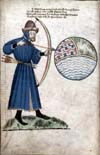| The Second Exile |
International
John Gower
Society
|
The
Second Exile In response to the letters he believes came from Olda and Bishop Lucius, Trevet’s King Alla sends the messenger back with instructions to keep Constance and Maurice safe until his return. The letters are intercepted, and counterfeited, and Constance and the baby are exiled once again upon the sea. Trevet’s version is approximately 250 words, summarized here:
In Gower’s version of the scene, although the storyline remains practically the same, there are important alterations and additions. Consequently, Gower’s scene runs much longer to some 540 words:
Gower makes several obvious alterations to this scene. Although there are many minor changes, the two most conspicuous ones occur in the description of the letter and the depiction of the exile scene. Gower carefully discloses the reason for the exile as being Moris’s claim to the throne. More importantly, Gower heightens the exile scene dramatically by giving us Constance’s heart-wrenching, emotional display, and her subsequent resolution to accept her fate out of love for her son. Gower quotes the entire content of the letter, whereas Trevet had merely summarized it. In Gower’s detailed account of the letter Constance is called a “faie” (CA, II, 1019), with the implication that Moris, as her son, inherits her traits. Accordingly, Gower’s exile is grounded in Moris’s birthright and the urgency lies in displacing him as a potential heir despite the fact that he is a mere infant. The letter states, “‘Hire child schal noght among hem duelle, / To cleymen eny heritage’” (CA, II, 1024-25). The exile is commanded because Moris is Constance’s son (“hire sone” is repeated twice in the letter). In Trevet’s account, the reason for their exile was politically unmotivated: if Constance “ele en la terre demorat, ceo avendroit a guerre et destruction de tote la terre par estrange nacions” [“remained in the land it would bring war and the destruction of the whole country by foreign nations”] (NLC, 327-28). There was in Trevet no hint of inheritance or lineage. Gower, unlike Trevet, avoids any political ramifications and redirects his focus to the issue of mother and son and what is at stake when lineage dictates one’s inheritance. Although written under false pretenses by a spiteful, jealous grandmother, Gower’s letter highlights an important element: maternity. The maternity theme escalates in Gower’s version when Constance is exiled. Interestingly, in Trevet’s account, as Constance increasingly became more stoic and saintly, she was significantly more distanced from her role as mother. In fact, her role as mother was relatively ignored. Constance showed little or no emotion in her acceptance of exile; it was the lords and the townspeople, “riches et povres, veuz et jeuvens” [“rich and poor, old and young”] (NLC, 353), who expressed sorrow. Perhaps because Trevet’s version had concerned itself with the protection of the kingdom—both land and citizens—he conflated sorrow for the loss of Constance with acceptance for the country’s sake. The citizens even cursed Alla, although they realized he was “n’ust il coupe” [“not at fault”] (NLC, 357). Consequently, Constance showed little emotion other than bravery at her fate because she knew that God would save her. Her acceptance of exile, thus, became secular and ecclesiastical with an almost matter-of-fact form of heroism. She was completely devoted to God and loyal to her adopted country. Gower’s Constance, however, accepts her exile solely for maternal reasons and with great emotional display. She is totally devoted to her child. Why does Gower dramatize this scene and recast Constance as such a defenseless woman? Why does he wait until she is surrounded by only the open sea and the heavens before he gives her a thespian acceptance speech? In contrast with Trevet’s disclosure of Constance’s quiet, compliant acceptance of her exile, Gower’s account of Constance’s exile becomes quite a theatrical event in which Constance not only speaks to God but also seems to speak to the audience. Even the setting of the scene differs conspicuously. In Trevet’s account, the setting was irrelevant. In fact, there was no reference to where Constance was when she verbally accepted her fate. On the other hand, Gower’s Constance immediately creates a powerful sense of exposed defenselessness:
One reason for this dramatic display is that Gower wishes to capture the full intensity of the pivotal moment in which Constance sinks into the abyss of despair and hopelessness and then resurrects herself. Constance submissively kneels upon a bare knee as she begs God to have compassion on her. In the midst of a seemingly unending sea, “thanne hire handes to the hevene / Sche strawhte, and with milde stevene / Knelende upon hire bare kne” (CA, II, 1055-57). She then swoons and falls to the deck of the ship. All the attention is centered on Constance’s fall and it appears that she longs for death. Gower consciously creates a character who is vulnerable and frightened; she is human, she is a woman, but she is also a mother. When Constance spots Moris, it is then, and only then, that she realizes she must survive in order for her son to live:
She claims that she must survive for “Moderhed” (CA, II, 1073) if nothing else. Gower gives no other reason for Constance’s rejuvenated will to live and acceptance of exile except for her role as a mother. In this scene, Constance regains self-control along with a renewed sense of self. Moris’s vulnerability and defenselessness, not hers, enables her to re-channel her own state of self-centeredness to a state of noble selflessness. Gower carefully crafts a pageant in which an emotionally distraught Constance is on the brink of total despair. He then dramatically turns the entire scene upside down as she not only regains control of her own self at the sight of her son, but also vows her complete dedication to him. The final lines of Gower’s version of this scene depict Constance gently weeping as she holds Moris in her arms. Then, in a moving portrait of motherhood, Constance nurses her child to sleep as she rocks him to the sound of her own gentle singing. There is no more powerful portrait of maternity than an infant at his mother’s breast—an unbreakable bond of love in its most natural state. In all its simplicity, this nurturing bond of closeness depicts a mother as loving, caring, and devoted. Since Gower emphasizes so much more profoundly than Trevet did Constance’s role as a gentle, devoted mother, rather than a strong, stoic saint, he elevates the concept of motherhood by focusing on a woman’s devotion to the well-being of her child. Gower alters the position of saint to that of dedicated mother. This approach makes the story of Constance much more her story, a woman’s story, a mother’s story. Trevet’s Constance was exiled not only with her son, but also with the large treasure she carried during her exiles. There was a mystery in what constituted that treasure and in why she needed to have it with her. Gower all but removes the treasure in his version. Gower’s Constance is given provisions on which to survive, but she has no treasure other than her beloved Moris. There is no mystery in her having only Moris to treasure since Gower’s emphasis is on mother and son. Gower defines woman through motherhood in his tale, but there are other mothers written into the tale who are unlike Constance. For instance, Constance’s own mother, Ytalie, is mentioned once and then never appears again. Early in the story, Constance is said to be “the doughter of an Emperour” (CA, II, 663) and her father does the negotiating for her marriage. Gower makes no further reference to Ytalie. The other “moders” who appear in the story are larger than life, unforgettable monsters. Both mothers-in-law are evil, aggressive, manipulative, deceptive mothers who create “treson” (CA, II, 1268), kill their “oghne Sone” (CA, II, 691), and send their grandson to exile. Yet, perhaps because these women wield secular power, Gower raises the idea that creating politically powerful women inevitably creates a dangerous situation. Is he attributing the idea that when women have too much power it is certain to lead to destruction? Childbearing is in itself a source of power which leads to an even greater and unique power—that of motherhood. In the story of Constance, the mothers, though all sharing maternal power, are also endowed with different kinds of power. Consequently, each uses her power differently. In Gower’s version, Constance is more than ready to relinquish all power of self, but as she laments, she discovers something to live for: her son. This discovery empowers her greatly and gives her new life. Trevet’s Constance lived primarily for God and Trevet focused greatly on the role of God in her life. There was almost no light shed on Constance as mother. She had been cast as more divine and even more superbly human. There was more of a sense in Trevet of the role of good versus evil, saint versus sinner, and Christian versus heathen. Those contrasts inevitably focused Trevet’s story of woman more directly on her role as a saintly creature. Constance was a powerful tool for Christianity, using her power in a positive manner to convert others. Her power was used to propagate the faith. Religion does not escape Gower’s Constance, but it is not so forcefully emphasized through her character. By focusing on the relationship between Constance and Moris, Gower demonstrates that Christianity is a religion of women, particularly those who are mothers. Trevet’s Constance, as her name implied, remained steadfast to her God and her country. Gower’s Constance, on the other hand, waivers in a human way. Her moment of wavering becomes the catalyst of a defining moment in the tale. As she embraces God, she also embraces her son. For Gower’s Constance, who becomes the mother of “the cristeneste of alle” (CA, II, 1598), motherhood is her most constant role.
Originally Posted: April 4, 2006 |
 |
"I throw my darts and shoot my arrows
at the world. But where there is a righteous man, no arrow strikes.
But I wound those who live wickedly. Therefore let him who recognizes
himself there look to himself." Site Hosting Provided Compliments of Western
Carolina University |
 |
